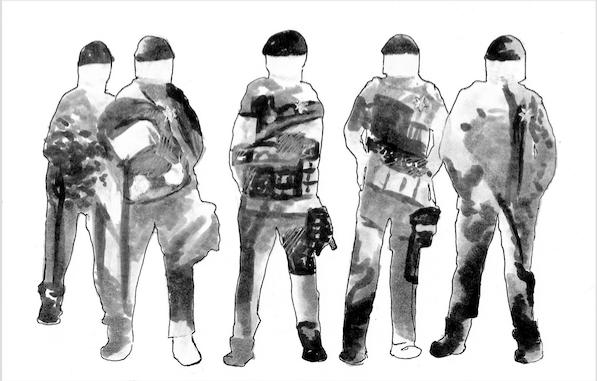Illustration by Siena Laws
If you’ve lived in the Bay Area through the past several years, you’ve probably heard a lot about police brutality. From 2014 onwards, fierce protests over police misconduct have filled the streets of Berkeley. But unless you follow the news very closely, you might not know how deep it goes. This film shows you.
The Force (it has nothing to do with Star Wars) is a documentary following the Oakland Police Department from 2014 to 2016, through the Black Lives Matter protests, a sex scandal, and three different chiefs. It is mainly told from the perspective of the officers and police chiefs themselves. While sometimes grim, it masterfully shows all sides of the issue and should be required viewing to understand police brutality.
On purely technical grounds, The Force is incredible. Each shot seems carefully planned and chosen. The film also has a well-crafted soundtrack, which gives it a tense, suspenseful feeling. It takes a fly-on-the-wall approach; the filmmaker prefers not to add narration or analysis, preferring to let the evidence shown speak for itself. This helps the viewer really become immersed in the movie, as well as letting the film seem impartial.
Rare among documentaries, this films seems to have no true agenda to push. Throughout the film, evidence is shown that both supports and opposes the police. In one memorable scene, a group of trainees view body camera video of a particularly brutal police shooting. A man is shot in front of his home thirteen times in the back while he exits his car.
To most viewers, this would seem like a clear-cut case of wrongdoing, but not to the trainees. Some of them get into a heated argument over whether it was justified. Sure, it looks unjustified, they say. But who knows? The man could’ve been reaching for a weapon. Procedure says to shoot to neutralize the threat, and the threat may not have been neutralized. As a viewer, you began to sympathize with the cop. Until another trainee responds that you have to “see a difference between one shot and 13 shots.”
The idea that nothing in policing is clear-cut wrong or right shows up often in this movie. Chief of Police Sean Whent is one of the major characters. Often, an interesting dynamic shows up when he attends press conferences or meetings with the public. He opens his mouth with the intent to acknowledge what more needs to be done in his department, but he quickly finds himself going off course. He gets defensive of his officers, saying that they work hard and that any issues are not the fault of his department. He clearly means well, but his tribalism and his combativeness, quickly take over. Instead of explaining to citizens, he argues with them.
This is one of many ways the film exposes the close-knit, insular culture of the police. In one scene, the police officers are spoken to on how to best respect citizens. They appear bored and irritated, and you can sympathize with them. They hear
the same stuff every day, usually from civilians. Who could blame the police officers for getting irritated at someone else thinking they can lecture them about how to do their jobs? Of course, they might need these lectures. They have problems to fix. But The Force shows, again that it’s not all clear-cut.
Of course, the movie isn’t just about the police. It’s also about Black Lives Matter, and many of the most memorable scenes are of that movement. The film shows the amount of raw anger that exists towards the police. When the police release video of a shooting that appears to exonerate the officers involved, one protester doesn’t believe it because “they are usually not telling the truth.” Another says “we do not believe there are good cops.” This anger exists, and is often somewhat justified. After all, the Oakland Police Department has consistently failed to hold itself accountable for its actions and had to be placed under federal oversight because of it. The people have a right to be angry.
The film does have a few flaws. It is often too fast-paced to understand what is going on and disorients the viewer. Dialogues and confrontations move so fast that they are hard to follow. In addition, the movie is extremely grim. There are very few laughs or jokes, or anything at all to make the viewer happy. This movie treats the topic with the respect it deserves
This movie displays all sides of the issue with not only clarity, but neutrality. If you are at all interested in learning about police brutality and the challenges that come with addressing it, or you’re curious about the long-lasting complicated relationship between Oakland’s police and the community, you should definitely watch The Force.


